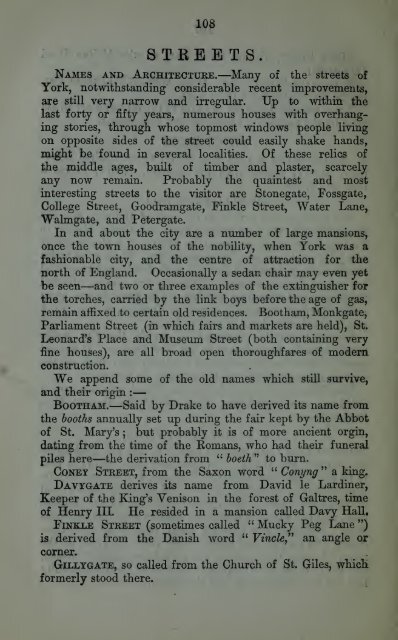practicalguideto00unse_0
You also want an ePaper? Increase the reach of your titles
YUMPU automatically turns print PDFs into web optimized ePapers that Google loves.
108<br />
STREETS.<br />
Names and Architecture.—^Many of tlie streets of<br />
York, notwithstanding considerable recent improvements,<br />
are still very narrow and irregular. Up to within the<br />
last forty or fifty years, numerous houses with overhanging<br />
stories, through whose topmost windows people living<br />
on opposite sides of the street could easily shake hands,<br />
might be found in several localities. Of these relics of<br />
the middle ages, built of timber and plaster, scarcely<br />
any now remain. Probably the quaintest and most<br />
interesting streets to the visitor are Stonegate, Fossgate,<br />
College Street, Goodramgate, Finkle Street, Water Lane,,<br />
Walmgate, and Petergate.<br />
In and about the city are a number of large mansions,<br />
once the town houses of the nobility, when York was a<br />
fashionable city, and the centre of attraction for the<br />
north of England. Occasionally a sedan chair may even yet<br />
be seen—and two or three examples of the extinguisher for<br />
the torches, carried by the link boys before the age of gas,<br />
remain affixed to certain old residences. Bootham, Monkgate,<br />
Parliament Street (in which fairs and markets are held), St.<br />
Leonard's Place and Museum Street (both containing very<br />
fine houses), are all broad open thoroughfares of modern<br />
construction.<br />
We append some of the old names which still survive,<br />
and their origin :<br />
Bootham.—Said by Drake to have derived its name from<br />
the booths annually set up during the fair kept by the Abbot<br />
of St. Mary's ; but probably it is of more ancient orgin,<br />
dating from the time of the Romans, who had their funeral<br />
piles here—the derivation from hoeth " to burn.<br />
Coney Street, from the Saxon word " Conyng '' a king,<br />
Davygate derives its name from David le Lardiner,<br />
Keeper of the King's Yenison in the forest of Galtres, time<br />
of Henry IIL He resided in a mansion called Davy Hall.<br />
Finkle Street (sometimes called " Mucky Peg Lane ")<br />
is derived from the Danish word " Fmc/e," an angle or<br />
corner.<br />
GiLLYGATE, SO called from the Church of St. Giles, which<br />
formerly stood there.















